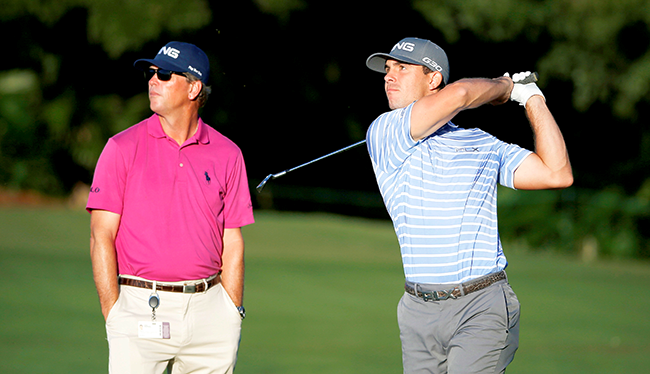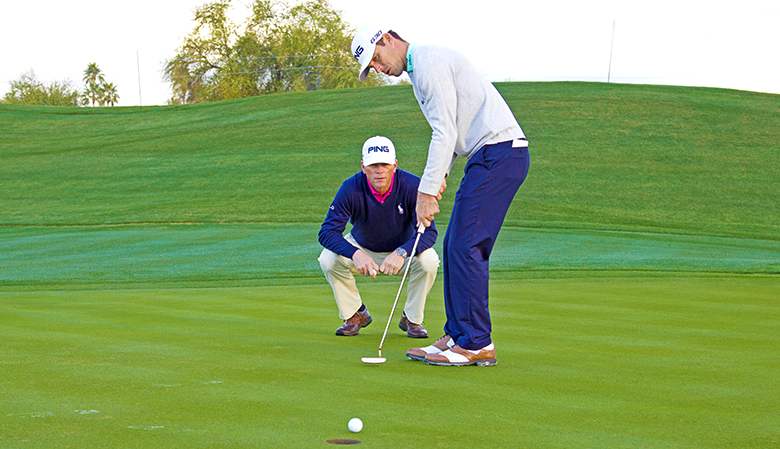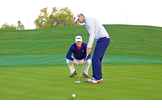Coach Q&A with Todd Anderson
Last updated:
The man Billy Horschel describes as ‘the best golf coach who has ever lived’ on learning something new every day, the perfect golfer and the three keys to a consistent swing.
How would you describe your teaching philosophy?
I think golf is about consistently controlling the ball and having the ability to hit each shot the proper distance and direction, with the required trajectory. Players must develop a consistent rhythm. If you can develop a repeatable shot pattern and create a one-way miss it makes the game so much easier and more fun.
Who’ve been your biggest influences?
I wouldn’t say I had one mentor or influence in particular. In the 1980s and ’90s, I was part of the Golf Digest Schools Instruction Staff and was able to learn from all the great teachers I worked with – Jim Flick, Bob Toski, Davis Love, Jack Lumpkin, Chuck Cook and a few others. Flick was a brilliant communicator and salesman. Love was able to explain any concept in a way that made it easy to understand. Cook was focused on the geometry and physics of the swing. Toski was so passionate and engaged with the students. I learned a lot from observing them all and have incorporated bits from each into my own teaching.
How complicated is the golf swing and are you still learning?
The golf swing can be as complicated or simple as you want to make it. If you can identify the cause of a problem in your own swing it can be simple, but if you focus on all the effects of the problem it becomes complicated. One of the keys of being a good teacher is being able to identify the difference between the cause and effect in the swing. Absolutely I am still learning new aspects of the swing, and I learn new ways of communicating with students every day. Here at Sea Island we have Trackman and the new G.E.A.R 3D Motion Capture System, which is extremely hi-tech software. Both are amazing tools but, ultimately, it is up to the teacher to interpret the information the technology provides and present it to the student in a way they can understand.
What was the last thing you learned?
Just this morning I was teaching a student who was swinging the club too low and left after impact causing her to hit a pull hook. We worked on getting a higher followthrough by putting her two palms together and hitting the palm of my hand with the back of her left hand in the correct position. Once she felt the proper position and had a visual of where it was supposed to be she improved immediately. It was the sort of lesson that just evolved slowly and suddenly we hit on an idea that not only affected the desired result but which the student also fully understood. We all learn in different ways. Some students are scientific and like facts, stats and data. Others like visuals or relate to feels or images. Teaching is an art and the teacher needs to assess how the student processes information. So you could say I learn something new every lesson.
With regard to swing mechanics, what is the most important thing to get right?
During the swing, I like students to get three things right. I want it to bottom out in the correct place, I want to see them align the clubface consistently with a path that produces the desired ball flight, and I want them to hit the ball in the centre of the clubface. If they have the proper pre-swing fundamentals, good rhythm, and get these things consistently correct, we’re on the road to good golf.
Can you coach simply from ball flight?
I know plenty of coaches that look only at the flight of the ball and coach successfully. I don’t totally disagree with that approach, but I prefer to also look at the player’s set-up and swing. I believe the pre-swing fundamentals of grip, alignment, ball position and posture are extremely important and will have a major influence on the player’s motion, clubface, club path, swing sequence and ball flight. The ball flight tells the story of what happened during the swing, but seeing the swing helps you identify the cause of the problem and prescribe any changes.
What is the coaching cliché you find most destructive?
I think there are a couple of phrases or popular concepts that are ill-conceived and probably cause more harm than good. I hear teachers and analysts say you should swing the club down the line toward the target. I disagree with that because the golf swing is more circular. The clubhead approaches the ball from very slightly inside the line, makes contact, then moves back inside. The other very well-known phrase I think misleads people is ‘clubhead speed’. I don’t think you should be trying to increase clubhead speed. You should be trying to increase club speed. If you focus only on the speed of the clubhead, the head tends to get ahead of the hands at impact, and the club ends up leaning backwards instead of forward slightly.

Are there areas of coaching you totally disagree with?
I’m not in favour of loading the left side in the backswing, but as with all methods, it may work for some. I believe the body should always be loading and rotating in the direction the club is swinging. Some teachers seem too intent on creating perfect rather than effective swings. Do you want to score style points, or shoot lower scores? It’s a game that requires many different skills, so you shouldn’t get bogged down on mechanics or one aspect.
Where does power come from?
It’s not one place. Power builds up in the swing and is then released into the back of the ball. The golfer creates a lever system in the backswing which, if developed correctly, stores up power. The body then begins to re-rotate in the downswing while shifting forward slightly. Really it’s all about proper sequencing. Once you have loaded up in the backswing, you need to release the energy with the correct sequence of moves in the downswing. But it all needs to be a flowing, fluid motion.
How important are the hands?
The most important part of any swing. They deliver the club to the ball so what they do is paramount. The importance of how you position your hands on the club and grip pressure cannot be overestimated. You might have the most beautiful pivot in the game, but it won’t work if your hands don’t perform correctly.
What is the single most important attribute a great player can have?
In terms of the swing, they need to be able to consistently get the clubface back to the ball in a way that produces the desired shot. They need to have good sequence of motion. As for attitude and character, I think they need to be able to play without fear, focus on the shot at hand, and not be conscious of the consequences.
What are the hardest changes for a good player to make?
Clubface-related issues. By seeking to change how the clubface is aligned at impact, it changes a player’s sequencing and feel, and that invariably affects their rhythm and tempo negatively.
Build your perfect golfer: Height, build, tempo, natural shot shape, etc.
He’s tall – about 6ft 2in – and very supple and flexible. He has a strong core and strong legs. Ideally, he plays with a neutral grip and keeps the clubface square throughout the swing, making it so much easier to diagnose and fix problems if and when they happen. Personality-wise, he is confident and believes he can beat anyone. He can handle adversity calmly and is able to score well on days when he isn’t hitting the ball as well as he’d like.

